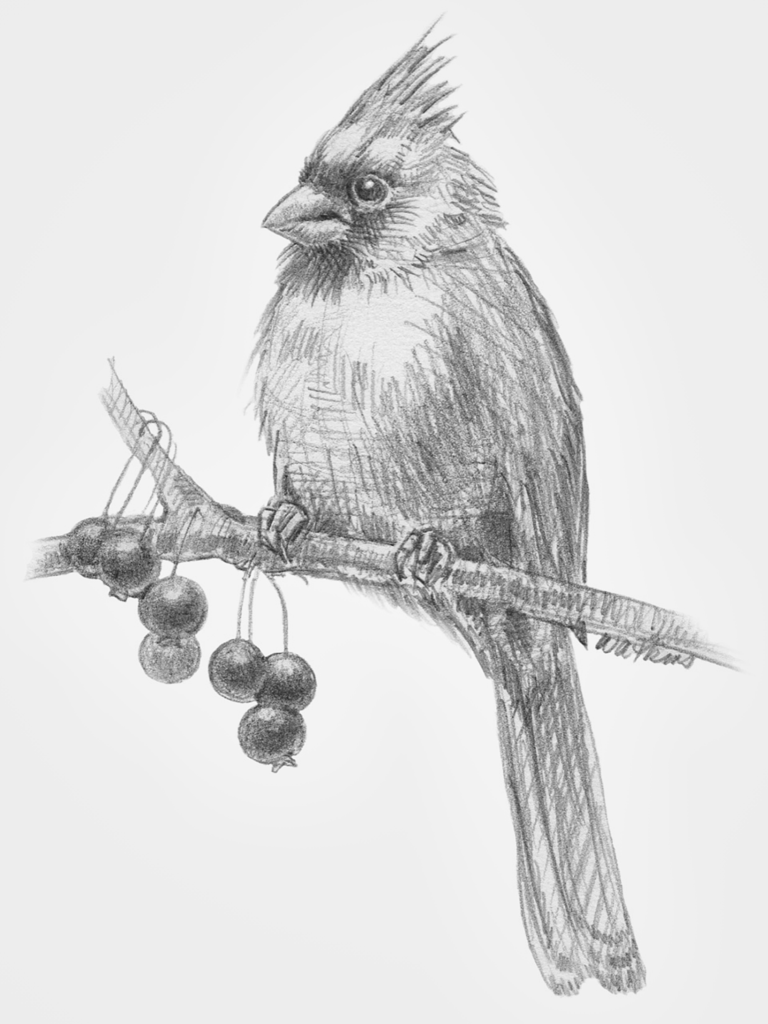November, A Room With a View
Through the Garden Gate
Text and Illustration by Leslie Watkins

In the nature loving-town we live in, enjoying the surrounding natural beauty doesn’t pause in winter. The sparkling landscape exposed by absent foliage affords a better view of the underlying design. Spending more time inside looking out encourages us to improve on the views we see from our windows. Windows perfectly frame the changing landscape as the sun moves across the sky creating shadow play. Weather alters the mood, and birds and squirrels animate the scene. It’s worthwhile to think about what we’d like to see while sitting by the fire, at our desks or from the kitchen table.
There are quite a few plants with beautiful winter interest and many that support birds and animals in frigid temperatures. Bringing birds closer to our windows is easy to do with a selection of attractive shrubs that provide both cover and food. Hanging bird feeders will greatly increase the range of species we attract. But don’t put birdseed out too soon. Seeing bears close to the house is exciting, but one misplaced claw can destroy your window screen, and ripped down feeders can result in damage to your property. More importantly, you could be jeopardizing the bear’s life. Habituated animals run the risk of being relocated or euthanized. And with milder winters, complete hibernation is now less likely. Some possible solutions to reduce bear visits are scattering smaller amounts of seeds at a time, raising feeders higher with pulley systems or simply relying on native plantings instead of feeders to attract the birds.
Leaving seed heads and dried flowers on plants like hydrangeas, echinaceas and rudbeckias provide good forage for birds, and they are very pretty when they collect frost and snow. Junipers, rhododendrons and arborvitae can provide a lovely backdrop to your winter views. Frost-proof garden ornaments make great focal points when covered in snow and may be decorated with winter greens and berries.
For a brilliant shot of color use red- and yellow-twig dogwood, Cornus stolonifera and cultivated varieties (cvs); winterberry, Ilex verticillata and cvs; and various other hollies. Some shrubs with interesting bark and branches are Harry Lauder’s Walking Stick, Corylus avellana ‘Contorta’; oakleaf hydrangeas, Hydrangea quercifolia; river birch, Betula nigra; Japanese maples, Acer palmatum; paperbark maples, Acer griseum; and Japanese stewartia, Stewartia pseudocamellia.
When planning your view, think about the direction of light and time of day. From a daytime workspace with western light you can watch light passing through ornamental grasses or leaves of the American beech, Fagus grandifolia. It might be nice to spend breakfast with the chickadees, or lunch with cardinals. Place your plantings to coordinate with the time of day that you’re most likely to be near those windows. Long shadows cast by the setting sun can be very dramatic.
Twinkle lights, wind chimes, birdbaths, stone and metal ornaments take on a new look in winter, as do natural things like grapevines, persisting fruits and flower heads, stonewalls and fences. Decorative outdoor furniture looks beautiful with a dusting of snow, or you can put a winter bouquet on your picnic table.
Natural Winter Bird Food
- Coreopsis
- Crabapples
- Dogwoods
- Echinacea
- Joe Pye weed
- Juniper
- Rudbeckia
- Sedums
- Silver birch
- Winterberry
